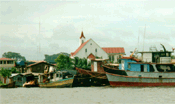

In 1986, linguist Judy Kegl traveled to Nicaragua on a professional visit she assumed would be fairly routine. The country's Ministry of Education had merely asked her to consult with a school for the deaf, and Kegl quite reasonably assumed that she would be in the country for only a few weeks, helping teachers find ways to do a better job of educating deaf children. Little did she suspect that she was about to witness, and then find herself documenting and analyzing, a landmark event in linguistic science.
Kegl had assumed that the Nicaraguan deaf would use a well-developed sign language, like deaf people in much of the rest of the world. But after she arrived, she learned that a rich, varied, and newly-constructed language made of signs was just then being born in the minds, hands, and faces of children.
Kegl, in short, was stunned to discover that she was present at the birth of a new language. An intriguing set of existing hypotheses had previously suggested that the capacity to invent language was innate in humans, present at birth. But there was simply no ethical way to test the hypothesis: researchers could hardly separate a group of babies from their parents in order to observe whether they developed a new language on their own.
Yet when Kegl visited the school, she quickly realized that she was observing that very experiment in process. In Nicaragua, a confluence of events had led to an unusual situation. Deafness had long been a stigmatized condition in Nicaragua. As a result, deaf individuals tended to be cloistered in their homes, hidden away. Few ever met other deaf people, nor became members of a Deaf community. Never met meant never married, which in turn meant even in cases where a child was born genetically deaf, his or her parents were usually not themselves deaf, but simply each a carrier of a recessive gene for the condition.
In other countries, says Kegl, "Typically you've got a sign language kind of passing down from generation to generation. In Nicaragua that didn't happen." Nor, in most cases, did deaf children have the option of learning a language by reading in Spanish, because illiteracy was so widespread.
At home, the children had used only crude gestures, "home signs," unique to each deaf individual. By the time Kegl arrived, a government literacy and education push had led to the opening of new schools for the deaf, but the children in the schools arrived with no way to communicate with each other, beyond trying to use the crude and dissimilar "home signs" each had used with parents or siblings.
Yet the children quickly began to find ways to communicate with each other. The initial group of older children who were brought to the school rapidly began developing their own simple rudimentary signed language -- not by learning it from their teachers, but by interacting with each other and systematically bringing it to life out of their collective "jumble of idiosyncratic homesign/gestural systems," as Kegl and two colleagues later described it. Kegl compares this initial language to a kind of pidgin. But then, as younger children arrived and began to observe and then acquire that initial, pidgin-like form of crude communication, they began to add richness and complexity to it. In a matter of only years it had virtually exploded into a sophisticated, and grammatically complex language.
"When I got there," says Kegl, "it became clear that there was something very interesting going on. The older signers had much more variability and their signing was less complete. But the younger signers were very, very fluent. What was clear, after awhile anyway, was that a new language had come into being, and we were literally looking at the first generation of users."
The development of this wholly new sign language, she says, buttresses the hypothesis that "we have innate language expectations, we have an innate propensity to learn a language, it has to be triggered, but once it's triggered we go through that process."
With funding from NSF's Linguistics Program, Kegl, currently Associate Professor of Linguistics at the University of Southern Maine, and a postdoctoral fellow, Romy Spitz, have been analyzing, transcribing, and archiving data about a wide range of factors related to the new language, including vocabulary and sentence structure. Using a series of short cartoons to generate "stories" from signers, she has now collected data from more than 1000 subjects, some of whom are home signers, others pidgin signers, and still others users of the full blown language form. Another key focus of her work has been to analyze the way in which a new group of deaf children of various ages acquire this language in two new schools where education for the deaf began only recently.
Kegl notes that there is so much to learn that her project can be, "overwhelming on some levels." But, she adds, "for a linguist to be able to watch a language come into being is a once in a lifetime opportunity. I have to say," she continues, "I thought I was going to go down there for a month. I was going to talk to some people, come back, and that was going to be it. And now it's been 13 years and, I expect, many more."
For more information please see:
|
This research is partially supported by the Linguistics Program. |
|
|




